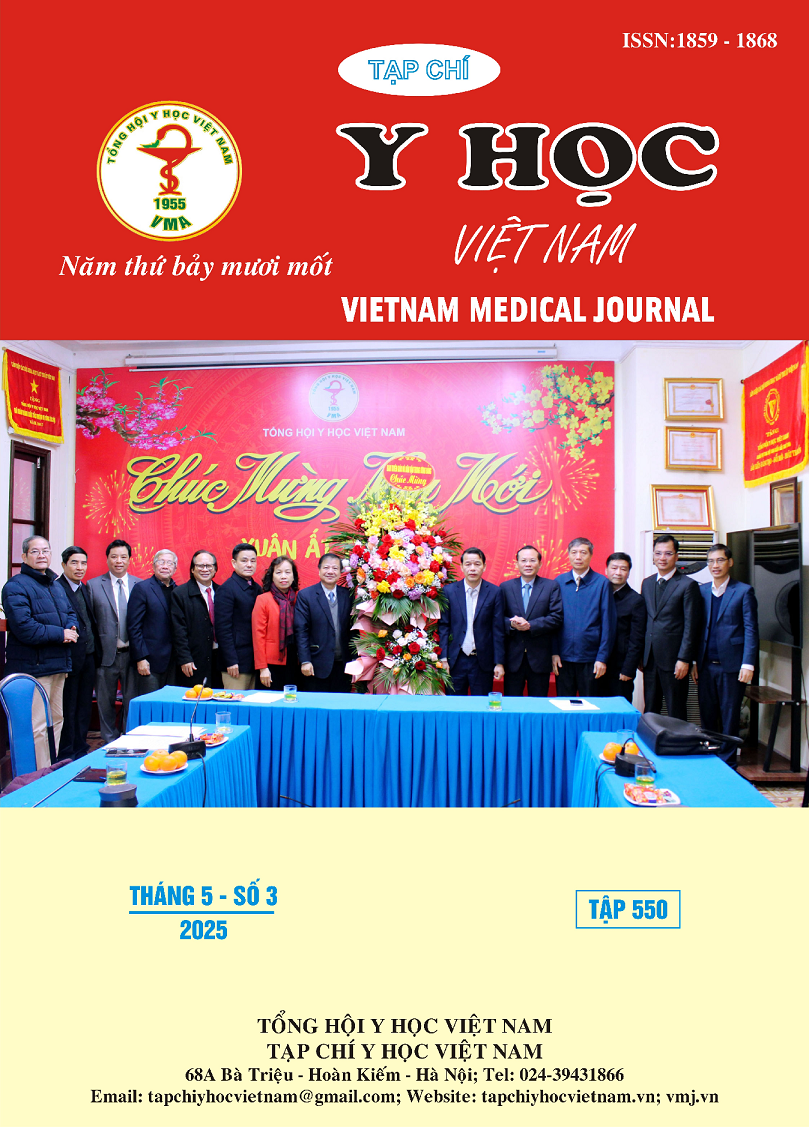AETIOLOGIES AND TREATMENT OUTCOMES OF NEONATAL RESPIRATORY DISTRESS AT THE THAI BINH PEDIATRIC HOSPITAL IN 2024
Main Article Content
Abstract
Objective: To describe the causes and treatment outcomes of neonatal respiratory distress at the Thai Binh Pediatric Hospital. Methods: A cross-sectional descriptive study was conducted on 217 neonates diagnosed with respiratory distress at the Thai Binh Pediatric Hospital from January 2024 to July 2024. Results: The majority of affected neonates were male (62.2%), with a mean gestational age of 37.65 ± 2.29 weeks and a mean birth weight of 2997 ± 595 grams. Among the cases, 71.9% had mild respiratory distress, 19.8% had moderate distress, and 8.3% had severe distress. Most patients (92.6%) recovered and were discharged, with an average treatment duration of 13.7 days. Pulmonary causes, primarily pneumonia, were the most common etiology (74.2%), while patent ductus arteriosus (6.9%) and neonatal infection (23.5%) were the leading causes in other categories. Factors associated with poorer treatment outcomes included preterm birth, low birth weight, cesarean delivery, and severe respiratory distress at admission. Conclusion: Neonatal respiratory distress is primarily caused by pneumonia, with most patients achieving favorable outcomes. However, preterm birth, low birth weight, cesarean delivery, and severe distress are risk factors for worse prognosis. Early identification and timely intervention are crucial for improving treatment outcomes.
Article Details
Keywords
respiratory distress, neonate, etiology
References
2. Newborns: improving survival and well-being. Accessed November 8, 2023. https://www.who.int/news-room/fact-sheets/detail/newborns-reducing-mortality
3. Nguyễn Thành Nam. Nghiên Cứu Nguyên Nhân, Yếu Tố Nguy Cơ và Kết Quả Điều Trị Suy Hô Hấp ở Trẻ Sơ Sinh Tại Khoa Nhi - Bệnh Viện Bạch Mai. Luận văn Tiến sĩ Y học. Học viện Quân Y; 2018.
4. Khu TKD. Thực trạng cấp cứu sơ sinh và mô hình bệnh tật cấp cứu sơ sinh tại các tuyến bệnh viện tỉnh hòa bình. tcnk. 2021;14(1). doi:10. 52724/tcnk.v14i1.15
5. Sivanandan S, Agarwal R, Sethi A. Respiratory distress in term neonates in low-resource settings. Semin Fetal Neonatal Med. 2017; 22(4): 260-266. doi:10.1016/j.siny.2017. 04.004
6. Hương NTX, Dung LTK, Sơn ĐT. Nguyên nhân suy hô hấp ở trẻ sơ sinh tại trung tâm Nhi khoa, bệnh viện Trung ương Thái Nguyên. VMJ. 2023;530(1). doi:10.51298/vmj.v530i1.6601
7. Vũ TC, Nguyễn TQN. Nguyên nhân và kết quả điều trị suy hô hấp ở trẻ sơ sinh tại bệnh viện Sản Nhi Nghệ An. VMJ. 2023;527(1B). doi:10.51298/ vmj.v527i1B.5783
8. Tuệ PTT, Anh PV, Tuyến NĐ. Nghiên cứu đặc điểm lâm sàng, cận lâm sàng và một số yếu tố liên quan đến suy hô hấp sơ sinh nặng tại bệnh viện Sản-Nhi tỉnh Quảng Ngãi. VMJ. 2023;529(1). doi:10.51298/vmj.v529i1.6315
9. Anh ĐTT, Nga NTQ. Nguyên nhân và kết quả điều trị suy hô hấp ở trẻ đẻ non tại khoa Sơ sinh, bệnh viện Đa khoa Xanh Pôn. VMJ. 2024;543(2). doi:10.51298/vmj.v543i2.11394
10. Nguyễn PTH, Trần CT, Nguyễn TN. Đánh giá kết quả điều trị suy hô hấp sơ sinh và một số yếu tố liên quan. VMJ. 2022;515(1). doi:10.51298/ vmj.v515i1.2680


